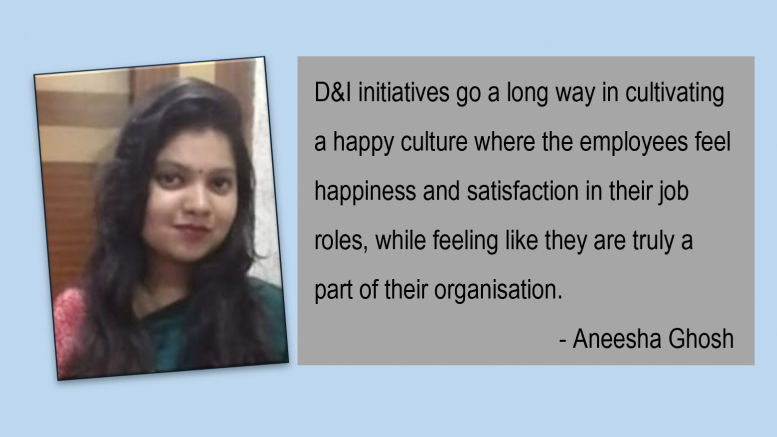Diversity and Inclusion are two interconnected concepts—but they are far from interchangeable. As the term suggests, “Diversity” in workplace is all about employing people from different, religious & political backgrounds, gender, ethnicity, education, socioeconomic background, sexual orientation and geographic location. “Inclusion”, on the other hand, is about creating a sense of belonging and making sure there are a set of behaviors that exhibit this. A sense of belonging is more than just symbolised participation, it’s about actually participating. Many DEI (Diversity, Equity and Inclusion) experts describe diversity as being “invited to a dance” and inclusion as “being asked to dance.” In other words, an organisation can have a diverse workforce, but if those employees’ voices aren’t heard and their perspectives aren’t included in business strategy, there is no meaning of supporting D&I as a culture. According to McKinsey & Co, “a business is likely to perform better financially if its workforce is more diverse” and a report by Deloitte found that when employees “think their organisation is committed to and supportive of diversity, and they feel included, their ability to innovate increases by 83%.”
However, the question arises that why is D&I important in the corporate world?
Research has shown many benefits of a diverse and inclusive workplace including higher revenue growth, greater readiness to innovate, increased ability to recruit a diverse talent pool and higher retention. In fact, inclusion is the most important aspect of a workplace culture to attain retention. If and when the employees start feeling that their ideas, presence or contributions are not truly valued or taken seriously by their organisation, it is given that they will eventually leave.
This brings us to some of the most important key points which make D&I a very important part of the working culture of an organisation.
- When an organisation has a diverse working environment, the employees have the creative space to come up with different and innovative ideas, using their diverse culture and knowledge. This in turn helps a business to stand out from other businesses which still use a single voice.
- The above point further helps in enlarging of a business by using different skills in the areas of problem solving and coming up with brainstorming ideas.
- People, now-a-days, look for jobs which supports diversity and inclusion, especially through their employees. This in turn helps a business to not only hire people having different mindset, but also best of the talents without any unnecessary prejudices.
- D&I initiatives go a long way in cultivating a happy culture where the employees feel happiness and satisfaction in their job roles, while feeling like they are truly a part of their organisation.
- Productivity of the work increases as well because of the same mentioned reasons.
- D&I not only helps a business improve internally, but externally as well. With diverse culture, the business comes up with diverse content to work on which in turn helps the business to gain a wider audience base.
A 2018 McKinsey study of 1,000 global companies found that increased gender and ethnic diversity is clearly and directly correlated with profitability. In fact, companies with greater diversity experienced a 33 percent increase in performance.
Many organisations claim to have a diverse workspace but lack in inclusivity. Such a situation, where diversity lacks inclusion, is termed as “tokenism”. An inclusive workplace doesn’t just have a diversity of people present, it has a diversity of people involved, developed, empowered and trusted by the business. The D&I concept also involves “Belonging” which ensures that everyone feels a sense of safety to bring their full, unique selves to work.
The L&D leaders (learning and development), usually play a key role in creating an inclusive organisational culture. Since their expertise is in the areas of leadership training and performance management, they can make a major impact in driving equitable work for all. Overall, continuous rather than one-time D&I training initiatives will help reduce unconscious bias and ensure that organisations make D&I an ongoing priority rather than a reaction to societal events or workplace incidents.
In the ever-changing world of business, one of the key drivers of success is people. As the world becomes a global village, an organisation will have more people in its workforce. This important metric has sparked a conversation around diversity and inclusion in the workplace, which for so long has received less attention than it required. The quotes of famous personalities such as Sundar Pichai and Malcolm Forbes sums it up quite well.
A diverse mix of voices leads to better discussions, decisions, and outcomes for everyone.
~ Sundar Pichai
Diversity: the art of thinking independently together.
~ Malcolm Forbes
The views and opinions published here belong to the author and do not necessarily reflect the views and opinions of the publisher.



Be the first to comment on "D&I paves a new path in the Corporate"